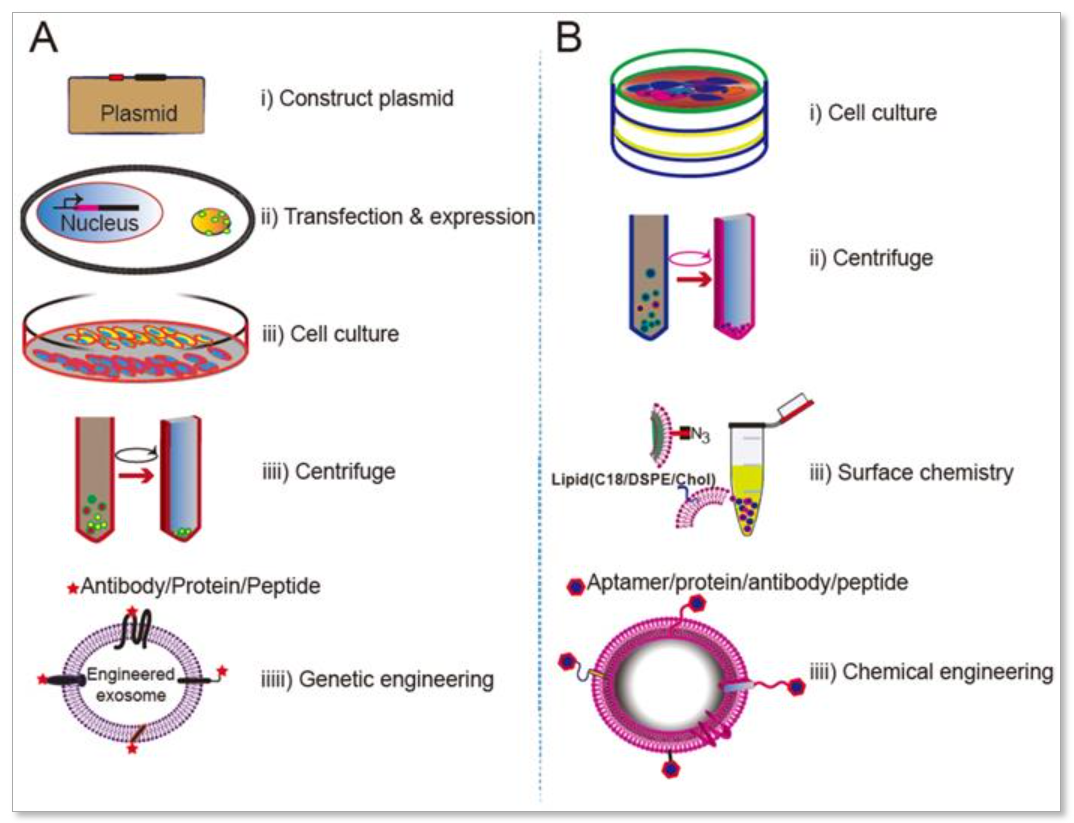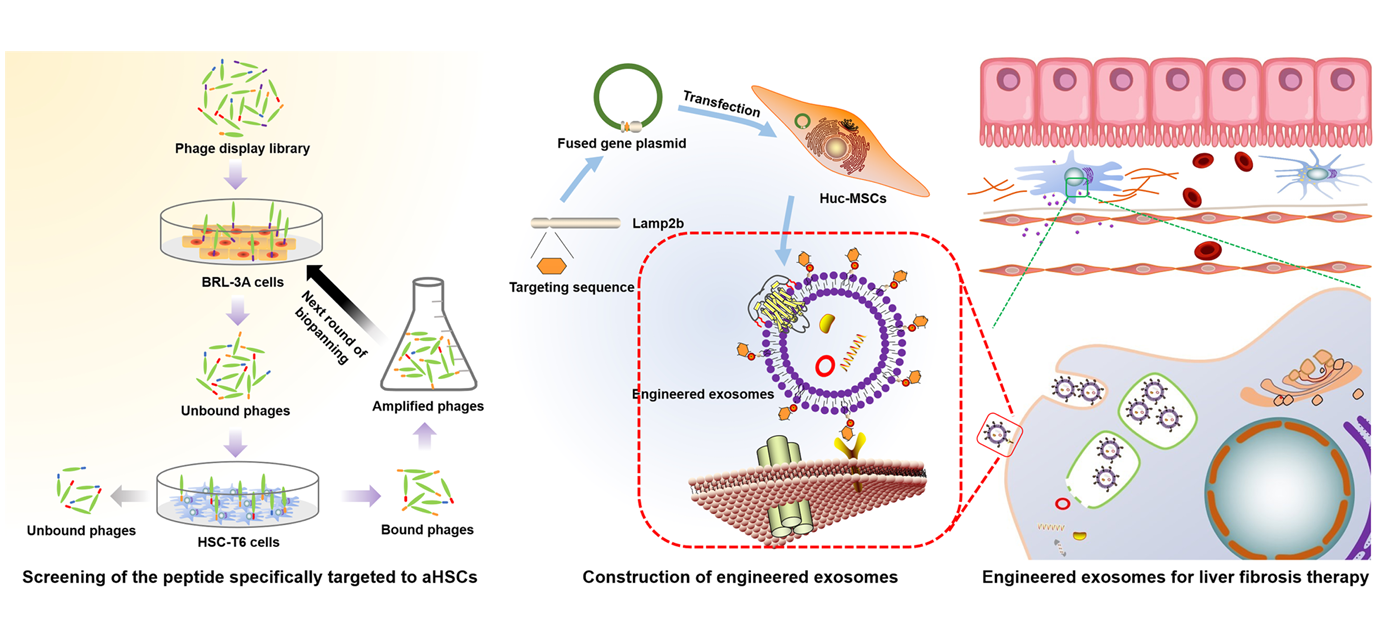Exosome Display-based Targeted Delivery Service
- Targeting ligand identification or screening based on specific cell types, surface receptors, or disease markers
- Fusion construct design linking selected ligands to exosomal transmembrane proteins
- Generation of stable or transient producer cell lines for engineered exosome secretion
- Exosome isolation, purification, and characterization by NTA, TEM, and surface marker analysis
- Validation of ligand display via Western blot, ELISA, or flow cytometry
- Optional therapeutic cargo loading, including siRNA, mRNA, proteins, or small molecules
- In vitro and in vivo functional validation, such as targeted uptake or delivery efficiency (optional)
Exosomes are nanoscale extracellular vesicles naturally released by most cell types, carrying a rich cargo of bioactive molecules including proteins, nucleic acids, lipids, and metabolites. These vesicles play a crucial role in intercellular communication and have gained increasing attention as carriers for therapeutic agents due to their intrinsic biocompatibility, low immunogenicity, and ability to cross biological barriers such as the blood-brain barrier. Despite these advantages, achieving targeted delivery remains a major challenge in exosome-based therapeutics. Native exosomes circulate systemically and are readily taken up by various cell types, which can lead to suboptimal therapeutic accumulation at the intended site and unintended off-target effects. To overcome this limitation, MtoZ Biolabs offers a comprehensive Exosome Display-Based Targeted Delivery Service that enables the design, construction, and functional validation of customized exosome display systems tailored to your specific delivery goals.
What Is Exosome Display Technology?
Exosome display technology refers to the molecular engineering of exosomal membranes to present functional targeting ligands on their surface, enabling cell-specific recognition and uptake. This approach transforms naturally non-specific exosomes into precision delivery vehicles by directing them to bind specific receptors on target cells or tissues. The core of exosome display lies in the fusion of targeting ligands—such as peptides or nanobodies—to transmembrane proteins enriched on the surface of exosomes. These transmembrane proteins are abundantly and stably incorporated into exosomal membranes during their biogenesis. When fused to targeting ligands, they serve as anchoring platforms that present the ligands outwardly on the exosome surface without disrupting vesicle integrity. Depending on the desired application, the ligands can be designed to recognize specific cell surface receptors, tissue-specific markers, or disease-associated epitopes. Upon systemic administration, these engineered exosomes selectively bind to the intended target cells, undergo endocytosis, and efficiently deliver their therapeutic cargo—such as siRNA, mRNA, proteins, or small molecules—into the cytoplasm.

Figure 1. Approaches for Engineering Exosomes Displaying Targeting Ligands
Service at MtoZ Biolabs
MtoZ Biolabs provides end-to-end solutions for exosome display and targeted delivery, including:
We employ robust platforms and molecular engineering techniques to ensure high expression, stable ligand incorporation, and preservation of exosome bioactivity. If you are interested in our Exosome Display-based Targeted Delivery Service, please feel free to contact us. Our technical specialists are available to provide a free business assessment.
Service Advantages
☑️Precision Targeting Capability
By displaying customized ligands on exosomal membranes, we enable cell- or tissue-specific delivery, significantly improving therapeutic selectivity and minimizing off-target effects.
☑️Versatile Ligand Options
Supports a wide range of targeting ligand adaptable to various disease models and delivery goals.
☑️End-to-End Engineering Workflow
From construct design and cell line development to exosome production, validation, and cargo loading, we offer a seamless, integrated solution.
☑️Validated Display and Delivery
Each project includes rigorous QC for exosome identity, ligand presentation, and optional functional delivery testing in vitro or in vivo.
Applications
1. Targeted Therapeutic Delivery
Engineer exosomes to selectively deliver therapeutic agents—such as siRNA, mRNA, proteins, or small molecules—to specific cell types or tissues, enhancing treatment efficacy and reducing systemic toxicity.
2. Drug Delivery System Development
Utilize exosome display as a platform to prototype and evaluate targeted delivery strategies for novel drugs, gene therapies, or biologics in preclinical research.
3. Exosome Engineering Research
Investigate the mechanisms of ligand display, vesicle targeting, and intracellular delivery using customized surface-modified exosomes as model systems.
4. Diagnostic Tool Development
Develop targeted exosomes as components of liquid biopsy platforms or imaging probes, enabling cell-specific capture or signal enhancement for disease detection.
Case Study
A recent study addressing liver fibrosis therapy successfully identified a targeting peptide (HSTP1) specific to activated hepatic stellate cells (aHSCs) using phage display screening. The peptide was genetically fused to the exosomal membrane protein Lamp2b and expressed in human umbilical cord mesenchymal stem cells, resulting in engineered exosomes displaying HSTP1 on their surface. These modified exosomes exhibited enhanced uptake by HSC-T6 cells in vitro and demonstrated a greater ability to induce phenotypic reversion of aHSCs compared to control exosomes. In vivo, HSTP1-displaying exosomes accumulated specifically in fibrotic liver tissue and co-localized with α-SMA-positive regions, indicating precise targeting and improved therapeutic outcomes. This case highlights the feasibility and effectiveness of exosome display technology for achieving cell-specific delivery in complex disease microenvironments.

FAQ
Q1: How is ligand display validated?
We perform verification using Western blotting, ELISA, flow cytometry, or other ligand-specific assays to confirm correct expression and surface localization.
Q2: Can the engineered exosomes be used in vivo?
Yes. We ensure the quality and sterility of exosome preparations for downstream in vivo studies, including biodistribution and functional delivery assessment.
Q3: What is the main advantage of using exosome display for targeted delivery?
Exosome display enables precise cell or tissue targeting by presenting specific ligands on the vesicle surface, improving delivery efficiency and reducing off-target effects compared to unmodified exosomes.
How to order?







